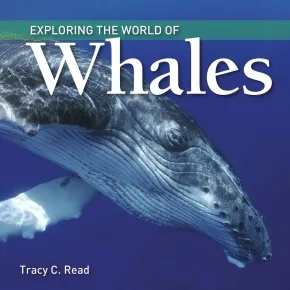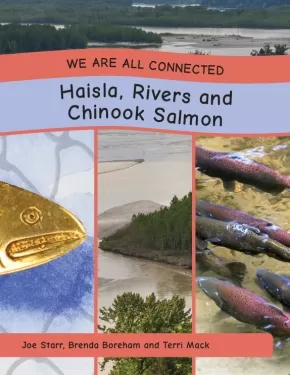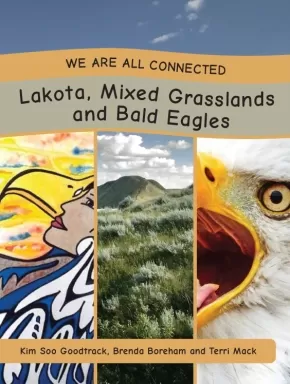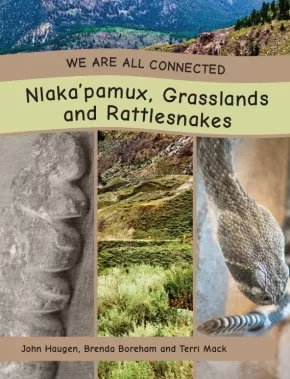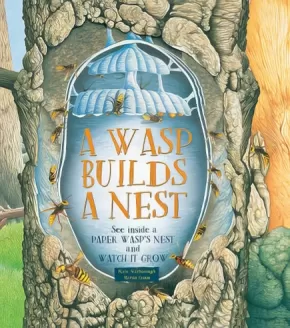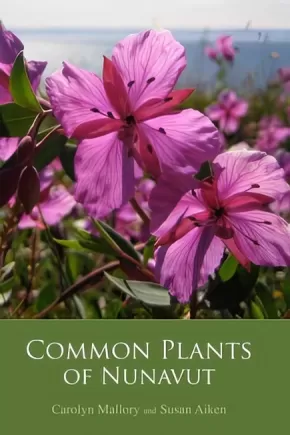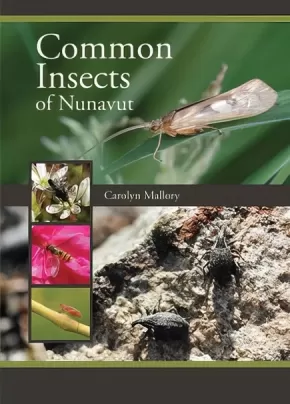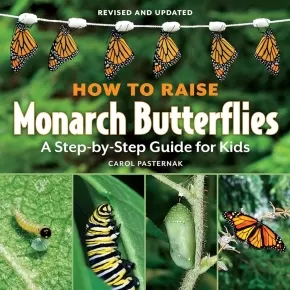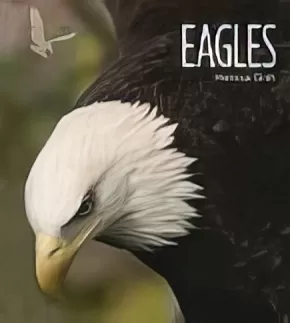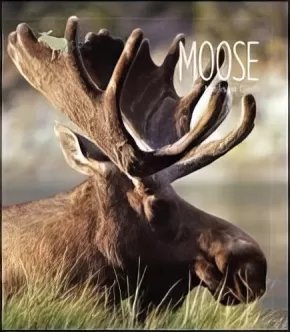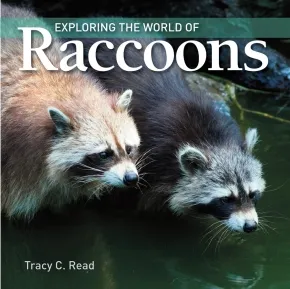
Life Cycles
61
-
75
of
85 Results;
Sort By
Go To
of 6
Exploring the World of Whales
$6.95
Format:
Paperback
ISBN / Barcode: 9781770859494
Synopsis:
Synopsis:
With sturdy, streamlined bodies, outfitted with insulating blubber, flippers, tail flukes and fins, whales -- all known as cetaceans -- are built for life in the water. In Exploring the World of Whales, we meet the baleen whales and the largest members of the toothed whales, including the killer whale, the biggest of the dolphins. These marine mammals range in size from the 108-foot-long (33 m) blue whale to the barely 9-foot-long (2.7 m) dwarf sperm whale while boasting a range of distinctive physical traits, including the sperm whale's gigantic head, the humpback's barnacle-covered body and outsized flippers, and the narwhal's eight-foot-long tusk.
Young readers will learn the difference between the baleen and toothed whales and how these differences affect habitat, diet and behaviors. They'll discover how whales communicate with one another across vast stretches of ocean, how some cooperate to raise families and hunt their prey, and how some are capable of remarkable feats of migration and deep diving. A lively, fully illustrated introduction to some of the planet's most intelligent species, this book also addresses the ongoing risks to whale populations.
Reviews
"Crisp photographs accompany interesting text that provides fascinating information about both baleen and toothed whales of many varieties. There's information here about diet, habitat, communication, behavior, and social interactions." — Teresa Bateman, Puget Sound Council for the Review of Children's and Young Adult Literature, August 2018
Educator & Series Information
Recommended for ages 7 to 12.
The Exploring the World of... nature series was created for young readers who are eager to learn more about the wild creatures of the world. Each title contains beautiful photographs of the animals in their natural habitats and the highly readable text explores their daily lives and physical characteristics, how they make their homes, how they raise their young and what they eat.
Additional Information
24 pages | 8.00" x 8.00" | full color throughout, index | Paperback
The Sockeye Mother
$23.00
Artists:
Format:
Hardcover
Text Content Territories:
Indigenous Canadian; First Nations; Gitxsan (Gitksan);
ISBN / Barcode: 9781553797395
Synopsis:
Synopsis:
To the Gitxsan people of Northwestern British Columbia, the sockeye salmon is more than just a source of food. Over its life cycle, it nourishes the very land and forests that the Skeena River runs through and where the Gitxsan make their home. The Sockeye Mother explores how the animals, water, soil, and seasons are all intertwined.
1 SMALL FRY
There’s a strong undertow today. The turbulent waters caress the backs of the little semelparous life forms emerging from their gravel nests. A small free-swimming fry bears witness to the currents of spring, after spending weeks developing and using up its nutritious yolk sack. It’s one of few remaining fry leaving its long winter’s home to seek out nursing waters.
This is the time of Wihlaxs (the black bear’s walking moon), which is early spring to the Gitxsan peoples of the Pacific Northwest Interior. Change is in the air, the days grow longer, and renewal is the life force that guides the world around the little fry’s waterways. Flora cells are starting to stir, preparing to bud and bring green to the landscape. Stores of food for the people along Xsan (river of mists) is running low, but preparations for the new seasons of fishing and gathering have begun. New snow falls to take away the old snow, which the Gitxsan call dalugwa.
Miso’o, or sockeye, are one of many species of salmon that call Xsan home. Although all species are valued, the Gitxsan prefer the flavour and number of Sockeye that return to their spawning grounds every year. The cultures along Xsan, otherwise known as the Skeena River, flourished and shaped their existence around the life cycles of this keystone species. Little does this small sockeye fry know that its life cycle not only nourishes the people and other beings along the watersheds, it is the whole reason the forests and landscapes exist.
2 TIME TO GROW
After a couple of years of “schooling” in the deeper parts of the nursing lake, this sockeye has become a smolt. Its little silvery body begins taking the shape of its blue-backed future self. The smolt is outgrowing the lake, and this signals Lasa ya’a (the spring salmon’s returning moon), so the little sockeye begins its treacherous journey down the Skeena.
As the spring salmons return, the sockeye smolts depart to relieve their urge for saliferous waters. April carries summer innuendos, as warm winds flow through nearly blooming flowers. The scent of pines and cedar waft across moist pillowy moss. The nets and rods of the Gitxsan people scour Xsan in hopes of taking part in the return of ya’a, the spring salmon. Ceremony is held and feasts occur to welcome the runs of salmon who come to replenish the land. It’s not only a time to give thanks, but also a time to send prayer that the salmon will always return, that they will provide nourishment for all that is living within its realm.
The young sockeye has so far avoided predation, dodged the unnaturally changing landscape denuding from the clear-cutting of man, and escaped the hungry hands of ’watxs, the otter. The smolt and her school have made their journey to the Pacific, and north to the ocean waters, where they will continue to feed and grow.
3 A REPLENISHING DEATH
For two years the sockeye mother has been feeding in the ocean waters, while avoiding sharks and killer whales. Through instinct, smell and much that is still not understood, the sockeye mother swims against the powerful currents of Xsan to return to the exact place in the rivers where she was spawned.
It’s now Lasa lik’i’nxsw (the grizzly bear’s moon). August is the time when all the Gitxsan people and grizzly bears pluck hundreds of thousands of sockeye from the Skeena. Many predators such as the grizzly discard most of the carcass. They carry their catch sometimes hundreds of metres into the forest, only to eat the fatty bellies and eggs. The decaying bodies of the salmon leaves nitrogen that nourishes the soil.
Battered and beaten by the journey, she is literally decaying due to lack of food and constant hard work. She finds a male partner who’s dug a nest to her liking. She lays her eggs. She can now die a replenishing death. The dying salmon bodies become fertilizer for all the flora that shape the great lands. Without the sockeye mother, the Gitxsan as they are, would simply not exist.
Awards
- The Science Writers and Communicators of Canada Award, Youth Category.
- McNally Robinson Book for Young People Award
Educator & Series Information
Recommended for Grades 4-7 for theses subject areas: Science, Social Studies.
This book is part of the Mother of Xsan series, which uses striking illustration and lyrical language to bring the poetry of the Xsan ecosystem to life.
Additional Information
| 32 pages | 6.50" x 10.00" |
We Are All Connected: Haisla, Rivers and Chinook Salmon
 $21.95
$21.95

Format:
Paperback
Text Content Territories:
Indigenous Canadian; First Nations; Haisla (Kitamaat);
ISBN / Barcode: 9781771742467
Synopsis:
Synopsis:
“We Are All Connected” is a series that explores how we all live together in a shared balance upon Mother Earth. Each book explores a specific ecosystem with a focus on one animal and its adaptations for survival within that ecosystem. Indigenous interviewees, each living within the same area, have responded to strategic questions as to how their community interacts with the land, their traditional territory. Explore each text with a sense of inquiry in mind.
8 We Are All Connected Titles Coast Salish, Coastal Rainforests and Cougars Haisla, Rivers and Chinook Salmon Inuit, Tundra and Ravens Lakota, Mixed Grasslands and Bald Eagles Métis, Wetlands and Mallards Nisga'a, Ponds and Leopard Frogs Nlaka'pamux, Grasslands and Rattlesnakes Sto:lo, Riparian Forests and Black Bears Each title covers the following curricular areas. Traditional storytelling and artwork begin each title from the focus Indigenous territory. Science: Biodiversity, classification, life cycles, food chains, food webs and connections between living and non-living things are just some of the science concepts included in each book. Social Studies: Contemporary and historical Indigenous cultural knowledge flows throughout each book. Local land forms, gatherings, harvesting practices and government are some of the social studies concepts included in each book.
2 Foundation Titles The two foundational books provide deeper understanding of the content of the “We Are All Connected” titles. We Are All Connected: The Earth, Our Home- explores biomes, ecosystems and biodiversity. We Are All Connected: The Earth, We Share- explores the interconnectedness between living and non-living things.
Authenticity Note: There is some Indigenous art in this book, such as a pendant carved by a Haida artist.
Additional Information
32 pages | 8.50" x 11.00" | ISBN: 9781771742467
We Are All Connected: Inuit, Tundra and Ravens
 $21.95
$21.95

Format:
Paperback
Text Content Territories:
Indigenous Canadian; Inuit;
ISBN / Barcode: 9781771742481
Synopsis:
Synopsis:
“We Are All Connected” is a series that explores how we all live together in a shared balance upon Mother Earth. Each book explores a specific ecosystem with a focus on one animal and its adaptations for survival within that ecosystem. Indigenous interviewees, each living within the same area, have responded to strategic questions as to how their community interacts with the land, their traditional territory. Explore each text with a sense of inquiry in mind.
8 We Are All Connected Titles Coast Salish, Coastal Rainforests and Cougars Haisla, Rivers and Chinook Salmon Inuit, Tundra and Ravens Lakota, Mixed Grasslands and Bald Eagles Métis, Wetlands and Mallards Nisga'a, Ponds and Leopard Frogs Nlaka'pamux, Grasslands and Rattlesnakes Sto:lo, Riparian Forests and Black Bears Each title covers the following curricular areas. Traditional storytelling and artwork begin each title from the focus Indigenous territory. Science: Biodiversity, classification, life cycles, food chains, food webs and connections between living and non-living things are just some of the science concepts included in each book. Social Studies: Contemporary and historical Indigenous cultural knowledge flows throughout each book. Local land forms, gatherings, harvesting practices and government are some of the social studies concepts included in each book.
2 Foundation Titles The two foundational books provide deeper understanding of the content of the “We Are All Connected” titles. We Are All Connected: The Earth, Our Home- explores biomes, ecosystems and biodiversity. We Are All Connected: The Earth, We Share- explores the interconnectedness between living and non-living things.
Authenticity Note: This title includes some Indigenous artwork and photographs, such as artwork from Tooma Laisa and Terri Mack.
Additional Information
32 Pages | 8.5" x 11" | ISBN: 9781771742481
We Are All Connected: Lakota, Mixed Grasslands and Bald Eagles
 $21.95
$21.95

Format:
Paperback
Text Content Territories:
Indigenous Canadian; First Nations; Sioux; Lakota;
ISBN / Barcode: 9781771742474
Synopsis:
Synopsis:
“We Are All Connected” is a series that explores how we all live together in a shared balance upon Mother Earth. Each book explores a specific ecosystem with a focus on one animal and its adaptations for survival within that ecosystem. Indigenous interviewees, each living within the same area, have responded to strategic questions as to how their community interacts with the land, their traditional territory. Explore each text with a sense of inquiry in mind.
8 We Are All Connected Titles Coast Salish, Coastal Rainforests and Cougars Haisla, Rivers and Chinook Salmon Inuit, Tundra and Ravens Lakota, Mixed Grasslands and Bald Eagles Métis, Wetlands and Mallards Nisga'a, Ponds and Leopard Frogs Nlaka'pamux, Grasslands and Rattlesnakes Sto:lo, Riparian Forests and Black Bears Each title covers the following curricular areas. Traditional storytelling and artwork begin each title from the focus Indigenous territory. Science: Biodiversity, classification, life cycles, food chains, food webs and connections between living and non-living things are just some of the science concepts included in each book. Social Studies: Contemporary and historical Indigenous cultural knowledge flows throughout each book. Local land forms, gatherings, harvesting practices and government are some of the social studies concepts included in each book.
2 Foundation Titles The two foundational books provide deeper understanding of the content of the “We Are All Connected” titles. We Are All Connected: The Earth, Our Home- explores biomes, ecosystems and biodiversity. We Are All Connected: The Earth, We Share- explores the interconnectedness between living and non-living things.
Authenticity Note: This work contains some Indigenous artwork and photographs throughout, such as artwork from Kim Soo Goodtrack.
Additional Information
32 pages | 8.50" x 11.00" | ISBN" 9781771742474
We Are All Connected: Métis, Wetlands and Mallards
 $21.95
$21.95

Format:
Paperback
Text Content Territories:
Indigenous Canadian; Métis;
ISBN / Barcode: 9781771742511
Synopsis:
Synopsis:
“We Are All Connected” is a series that explores how we all live together in a shared balance upon Mother Earth. Each book explores a specific ecosystem with a focus on one animal and its adaptations for survival within that ecosystem. Indigenous interviewees, each living within the same area, have responded to strategic questions as to how their community interacts with the land, their traditional territory. Explore each text with a sense of inquiry in mind.
8 We Are All Connected Titles Coast Salish, Coastal Rainforests and Cougars Haisla, Rivers and Chinook Salmon Inuit, Tundra and Ravens Lakota, Mixed Grasslands and Bald Eagles Métis, Wetlands and Mallards Nisga'a, Ponds and Leopard Frogs Nlaka'pamux, Grasslands and Rattlesnakes Sto:lo, Riparian Forests and Black Bears Each title covers the following curricular areas. Traditional storytelling and artwork begin each title from the focus Indigenous territory. Science: Biodiversity, classification, life cycles, food chains, food webs and connections between living and non-living things are just some of the science concepts included in each book. Social Studies: Contemporary and historical Indigenous cultural knowledge flows throughout each book. Local land forms, gatherings, harvesting practices and government are some of the social studies concepts included in each book.
2 Foundation Titles The two foundational books provide deeper understanding of the content of the “We Are All Connected” titles. We Are All Connected: The Earth, Our Home- explores biomes, ecosystems and biodiversity. We Are All Connected: The Earth, We Share- explores the interconnectedness between living and non-living things.
Authenticity Note: This book contains some Indigenous artwork and photos throughout, such as artwork from Leah Marie Dorion.
Additional Information
32 pages | 8.50" x 11.00" | ISBN: 9781771742511
We Are All Connected: Nlaka'pamux, Dry Grasslands and Rattlesnakes
 $21.95
$21.95

Format:
Paperback
Text Content Territories:
Indigenous Canadian; First Nations; Salish; Interior Salish; Nlaka'pamux (Thompson);
ISBN / Barcode: 9781771742528
Synopsis:
Synopsis:
“We Are All Connected” is a series that explores how we all live together in a shared balance upon Mother Earth. Each book explores a specific ecosystem with a focus on one animal and its adaptations for survival within that ecosystem. Indigenous interviewees, each living within the same area, have responded to strategic questions as to how their community interacts with the land, their traditional territory. Explore each text with a sense of inquiry in mind.
8 We Are All Connected Titles Coast Salish, Coastal Rainforests and Cougars Haisla, Rivers and Chinook Salmon Inuit, Tundra and Ravens Lakota, Mixed Grasslands and Bald Eagles Métis, Wetlands and Mallards Nisga'a, Ponds and Leopard Frogs Nlaka'pamux, Grasslands and Rattlesnakes Sto:lo, Riparian Forests and Black Bears Each title covers the following curricular areas. Traditional storytelling and artwork begin each title from the focus Indigenous territory. Science: Biodiversity, classification, life cycles, food chains, food webs and connections between living and non-living things are just some of the science concepts included in each book. Social Studies: Contemporary and historical Indigenous cultural knowledge flows throughout each book. Local land forms, gatherings, harvesting practices and government are some of the social studies concepts included in each book.
2 Foundation Titles The two foundational books provide deeper understanding of the content of the “We Are All Connected” titles. We Are All Connected: The Earth, Our Home- explores biomes, ecosystems and biodiversity. We Are All Connected: The Earth, We Share- explores the interconnectedness between living and non-living things.
Authenticity Note: This title includes some authentic Indigenous photographs.
Additional Information
32 pages | 8.50" x 11.00" | ISBN: 9781771742528
We Are All Connected: Sto:lo, Riparian Forests and Black Bears
 $21.95
$21.95

Format:
Paperback
Text Content Territories:
Indigenous Canadian; First Nations; Salish; Coast Salish; Sto:lo;
ISBN / Barcode: 9781771742450
Synopsis:
Synopsis:
“We Are All Connected” is a series that explores how we all live together in a shared balance upon Mother Earth. Each book explores a specific ecosystem with a focus on one animal and its adaptations for survival within that ecosystem. Indigenous interviewees, each living within the same area, have responded to strategic questions as to how their community interacts with the land, their traditional territory. Explore each text with a sense of inquiry in mind.
8 We Are All Connected Titles Coast Salish, Coastal Rainforests and Cougars Haisla, Rivers and Chinook Salmon Inuit, Tundra and Ravens Lakota, Mixed Grasslands and Bald Eagles Métis, Wetlands and Mallards Nisga'a, Ponds and Leopard Frogs Nlaka'pamux, Grasslands and Rattlesnakes Sto:lo, Riparian Forests and Black Bears Each title covers the following curricular areas. Traditional storytelling and artwork begin each title from the focus Indigenous territory. Science: Biodiversity, classification, life cycles, food chains, food webs and connections between living and non-living things are just some of the science concepts included in each book. Social Studies: Contemporary and historical Indigenous cultural knowledge flows throughout each book. Local land forms, gatherings, harvesting practices and government are some of the social studies concepts included in each book.
2 Foundation Titles The two foundational books provide deeper understanding of the content of the “We Are All Connected” titles. We Are All Connected: The Earth, Our Home- explores biomes, ecosystems and biodiversity. We Are All Connected: The Earth, We Share- explores the interconnectedness between living and non-living things.
Authenticity Note: This book contains some Indigenous artwork and photographs, such as photos from Rod Peters and artwork from Celestine Aleck.
Additional Information
32 pages | 8.50" x 11.00" | ISBN: 9781771742450
A Wasp Builds a Nest: See Inside a Paper Wasp's Nest and Watch It Grow
$12.95
Format:
Hardcover
ISBN / Barcode: 9781770856950
Synopsis:
Synopsis:
Children (and adults, too) have become aware of the ecological importance of bees. Wasps are ecologically important, too. They pollinate plants and provide pest control by eating insects and feeding them to their young.
Paper wasps construct open-celled paper nests. A mated female wasp -- the queen -- starts the nest by chewing wood fibers into a pulp to build paper layers. As soon as she has built enough of the nest, she lays some eggs which grow into young female wasps. They lay more eggs, mostly males, and these become workers whose job is to build the nest for the growing colony. It can end up being quite large. Come winter, the old queen and the workers die and the young females hibernate. In spring, they will be new queens that will build their own nest for a new wasp colony.
This elegantly illustrated book explains stage by stage in easy text how a wasp nest is built. It follows by days and weeks and shows how the queen's industrious workers create a sturdy, weatherproof home. Readers see the inside of the growing nest where the eggs turn into larvae and emerge 20 days later as juveniles. As the nest gets bigger and the story progresses, the book's pages become bigger too. Cross sections show the amazing construction of the nest and how the wasps live and work.
The interior pages in A Wasp Build a Nest are shingled, starting as a partial page and getting larger as the story progresses.
Reviews
"Readers are invited to experience the construction of a wasp's nest. Each shingled page reveals an inside look at the step-by-step progress of building the nest from start to finish--both the nest and the pages grow together. Readers will learn about wasp anatomy, reproduction, life cycle, and nest structure... This book is a great option for readers who are comfortable learning new vocabulary, as it provides so much information about wasps and their behavior." — Samantha D'Acunto, New York Botanical Garden Blog, May 2018
"This colorful book presents a close-up view of a new wasp nest in a hollow tree... Though visually the book is tightly focused on the nest and its growing complexity, within that context, both the text and the illustrations convey a good deal of information about the life cycle of wasps, their stages of development, and the different roles played by the queen, the males, and the female workers. Each double-page spread displays the growing nest along with pictures of detail such as the pupal development. The cutaway views of the nest, the cones, and the cells are particularly effective. Each sturdy, glossy page is about one centimeter wider than the preceding one, giving the book's interior an attractive, layered look. A well-focused, informative book on wasps and their nests." — Carolyn Phelan, Booklist, October 2016
"Wasps are often a source of fear and discomfort for children, but this title does a compelling job of showing wasps in a more favorable light. The book opens with a queen wasp awakening from hibernation and follows her through the creation of a colony to her eventual death in the fall. The information is presented scientifically but is also accessible for young readers, with any potentially unfamiliar words well explained. The illustrations are detailed and support the text. The view of the inside of a wasp's nest is likely new to most, and students will find it helpful to see the structures in question. The pages are shingled, starting as a quarter-page and gradually expanding in size until they fill the full dimensions of the book, which works well to mimic the growing colony depicted in the illustrations. The material emphasizes the growth of the wasps and the colony rather than what wasps do outside of the hive; however, this narrow focus keeps the text from becoming confusing for younger readers. A pleasing introduction to wasps and their life cycle, suitable for young entomology fans. Consider for most libraries." — Ellen Norton, School Library Journal, November 2016
Additional Information
24 pages | 8.50" x 9.50"
Common Plants of Nunavut
$19.95
Format:
Paperback
Text Content Territories:
Indigenous Canadian; Inuit;
ISBN / Barcode: 9781927095195
Synopsis:
Synopsis:
Explore the fascinating world of Nunavut’s varied plant life in this richly visual, informative book.
Through beautiful photographs and a broad range of information including traditional knowledge about plant use compiled through interviews with Inuit elders readers will learn about the appearances, adaptations, life cycles, and habitats of the diverse array of plants that live in the North.
Far beyond a barren land of ice and snow, this book will introduce readers to the beautiful variations of plant life that abound on the tundra.
Additional Information
205 pages | 9.00" x 6.50"
Common Insects of Nunavut (2 in Stock) - ON SALE!
$15.00 $19.95
Format:
Paperback
Text Content Territories:
Indigenous Canadian; Inuit;
ISBN / Barcode: 9781927095003
Synopsis:
Synopsis:
Explore the fascinating world of Nunavut's insects in this richly visual, informative book. Through beautiful photographs and a broad range of information—including traditional knowledge compiled through interviews with Inuit elders—readers will learn about the appearances, adaptations, life cycles, and behaviors of the diverse array of arthropods that live in the North.
This detailed non-fiction book is perfect for middle school and high school students looking to learn about the insects that survive in one of the world's coldest climates.
Additional Information
32 pages | 9.00" x 6.50"
How to Raise Monarch Butterflies: A Step-by-Step Guide for Kids
$8.95
Format:
Paperback
ISBN / Barcode: 9781770850026
Synopsis:
Synopsis:
Revel in one of the most remarkable miracles of nature.
Observing a Monarch butterfly as it transforms itself from a black, white and yellow caterpillar and emerges from a chrysalis as a vivid orange, black and white butterfly is among the most thrilling experiences that nature offers. Raising Monarch butterflies from eggs collected from milkweed leaves, or from caterpillars plucked from the plant, is made easy with the help of this detailed guide to locating and hatching this distinctive insect.
With more than 50 unique, close-up photographs readers will learn about the life cycle of the Monarch and how to encourage populations in their own backyards, with tips on which plants to grow, as well as the care and feeding of their pet caterpillars. How to Raise Monarch Butterflies explains what threats face Monarchs and how readers can help conserve the Monarch's feeding grounds from encroachment.
The Monarch's amazing story doesn't end after it flutters away as a butterfly. In the fall, monarchs wing their way southward toward warmer climes in Mexico and California, and congregate in mass groupings in certain regions. The following spring, the cycle begins all over again.
Additional Information
48 pages | 8.00" x 8.00" | full color illustrations and photographs throughout, glossary, resources, index
Living Wild: Eagles (2 in stock) - ON SALE
$12.00 $17.00
Format:
Paperback
ISBN / Barcode: 9780898125511
Synopsis:
Synopsis:
The crushing bite of alligators, the unique coloration of killer whales, the antler growth cycles of moose, and the defining characteristics of five other fascinating animals are explored in Living Wild. Vivid photographs transport readers on a virtual field study to observe the life cycle and behaviors of the featured creature.
Beautiful photographs, Pacific Northwest Coast legend, glossary and index included.
Additional Information
48 pages | 9.46" x 10.60"
Living Wild: Moose (4 in Stock) - ON SALE!
$13.50 $17.00
Format:
Paperback
ISBN / Barcode: 9780898125566
Synopsis:
Synopsis:
The crushing bite of alligators, the unique coloration of killer whales, the antler growth cycles of moose, and the defining characteristics of five other fascinating animals are explored in Living Wild. Vivid photographs transport readers on a virtual field study to observe the life cycle and behaviors of the featured creature.
Beautiful photographs, Menominee legend, glossary and index included.
Additional Information
48 pages | 9.50" x 9.28"
Exploring the World of Raccoons
$6.95
Format:
Paperback
ISBN / Barcode: 9781554076178
Synopsis:
Synopsis:
A glimpse inside the daily life of nature's masked bandits.
Children find the bandit-masked face and button nose of a raccoon irresistibly cute, and catching a glimpse of one in a neighborhood tree never fails to excite. Raccoons describes the natural history of these cousins of the panda bear and explains how that heritage helps them thrive in cities as well as in fields and woodlands. Color photographs of adults and kits in urban and natural settings give readers the chance to look more closely at these elusive creatures, and children will enjoy the amusing descriptions of the raccoon's antics and mischief. But Raccoons also shows youngsters why they shouldn't feed these brazen visitors and that, even though they share our cities and towns, raccoons will always be wild animals.
Educator & Series Information
Recommended for ages 7 to 12.
The Exploring the World of... nature series was created for young readers who are eager to learn more about the wild creatures of the world. Each title contains beautiful photographs of the animals in their natural habitats and the highly readable text explores their daily lives and physical characteristics, how they make their homes, how they raise their young and what they eat.
Additional Information
24 pages | 8.00" x 8.00" | Full-colour photographs throughout, index | Paperback
Sort By
Go To
of 6

